1884: ‘Chivalrous exchange of courtesies’ at the sham fight
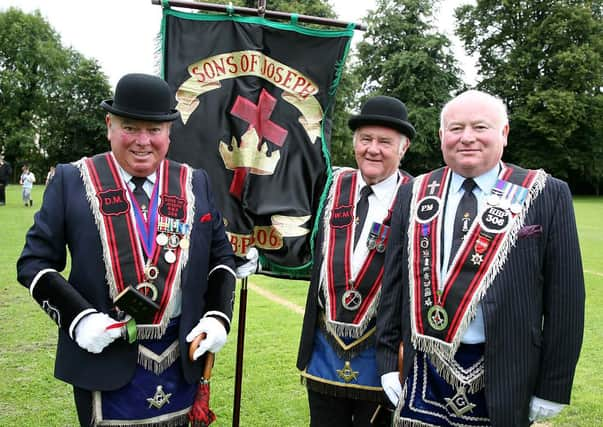

The News Letter editorial commented: “The sham fight which, in accordance with the traditions of the neighbourhood, took place at Scarva yesterday, was by far the most imposing demonstration of this type that has been held within the memory of the ‘oldest inhabitant’.
“There are in the neighbourhood men whose recollections include the celebrations of forty and even fifty years ago, and who have never been absent from the field of mimic battle whenever the anniversary has been celebrated; and they declare that upon no previous occasion did they witness an assemblage of so many persons as were present at Scarva yesterday.
Advertisement
Hide AdAdvertisement
Hide Ad“The spacious field within the demesne of Mr John Temple Reilly, DL, JP – a gentleman who was a a witness of the conflict yesterday – was crowded by at least 40,000 loyalists, and the manoeuvring of the troops on either side, not being of a very intricate character, was extremely effective from a spectacular standpoint.
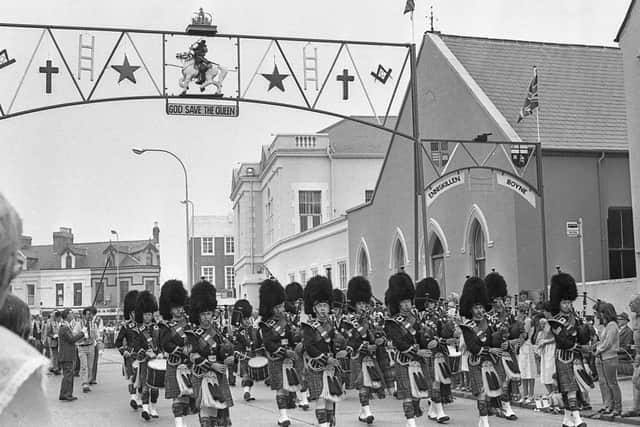

“The chivalrous exchange of courtesies between the representatives of the rival Monarchs, when the bloodless strife bad come to an end, was highly gratifying to the immense and enthusiastic crowd.”
The editorial concluded: “It is unnecessary to say that the Jacobite army was to all intents and purposes completely annihilated.”
In a later report on the day’s proceedings the News Letter noted: “If numbers constitute one of the main factors in considering the importance of such a demonstration, then this day’s proceedings unquestionably prove, in opposition to the statements of all gainsayers, that the time-honoured mimic fight has lost none of its significance.
Advertisement
Hide AdAdvertisement
Hide Ad“A passenger from Belfast to Dublin, or vice versa, passing the little station of Scarva on an ordinary occasion could form no idea of the transformation which could be effected in a single day. A little country village, with an inn and a few houses nestling together, and here and there, perhaps, a child playing about, are usually the only signs of life that a person notices as the train passes on ordinary days, but on the 13th of July in each succeeding year, or rather the 14th in this year of grace, what a change takes place.”
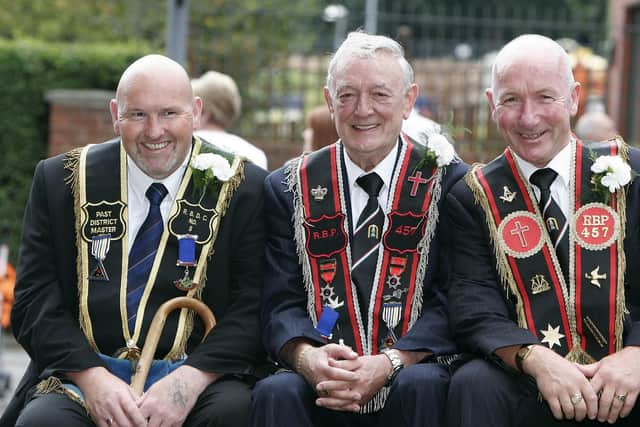

From an early hour special trains ran at intervals from Portadown, “each one freighted to the utmost extent”, and from those districts where railway accommodation could not be obtained, the different lodges marched by road or proceeded in vehicles, accompanied by “great numbers of sympathising friends”.
In addition to those from local quarters, Belfast, Newry, London, Glasgow and other large centres sent their contingents. including Banbridge, Lisburn, Lurgan, Portadown, Armagh, Dungannon, Poyntzpass, Rathfriland, Glenanne, Markethill, Gilford and Tandragee.
Among the large number of bands in attendance that day there were the Young Britons Flute Band from Belfast, the Rathfriland Conservative Flute Band, the Armagh Amateur Flute Band,the Lurgan Conservative Flute Band, the Banbridge Conservative Flute Band, the Banbridge Britannia Flute Band, the Newry Conservative Flute Band and the Glenanne Flute Band.
Advertisement
Hide AdAdvertisement
Hide AdIndeed, praise was given to the Great Northern Railway Company. It was noted: “The Great Northern Railway Company gave every facility for travelling to those desirous of visiting this town, by numerous special trains at excursion fares, and every advantage was taken of the inducements thus offered, and the officials one and all were untiring in their exertions to further the comfort of all visitors. The railway arrangements were perfect that all were returned to Belfast and elsewhere in a remarkable short time.”
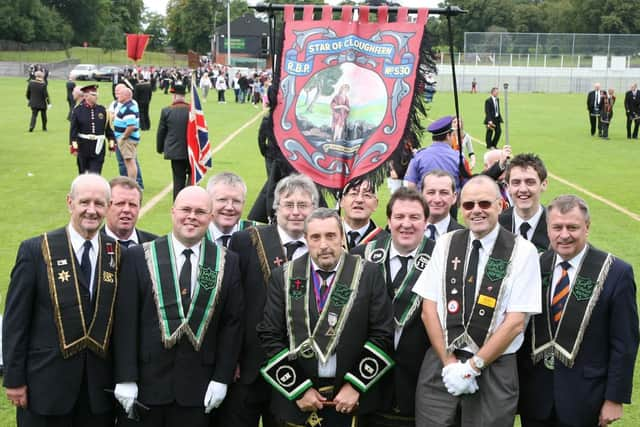

Before the start of “the fight” the different lodges marched past Mr Temple Reilly’s picturesque residence, each in turn halting for a few minutes opposite the hall door, where Mr and Mrs Temple Reilly and the members of their family had taken up their position, each of the respective bands meanwhile played some well-known airs. On the band of the Rathfriland Lodge, from London, taking their place opposite the house, under the leadership of Mr Samuel Geddis, the National Anthem was struck up and “cheering and waving of hats was indulged in most enthusiastically”.
CHEERS FOR THE HOUSE OF LORDS
While this was going on Mr Temple Reilly picked up a Royal Standard which happened to be in the porch and waved it several times in front of the house “imparting to the scene an impressiveness as unique as it was interesting”, noted the News Letter’s correspondent.
Three cheers were then called for the House of Lords by Mr Temple Reilly, who said that the Upper House of Commons “formed one of the strongest bulwarks of our their glorious Constitution, and any man who wishes to do away with that House was a traitor to the principles which we all love to cherish”.
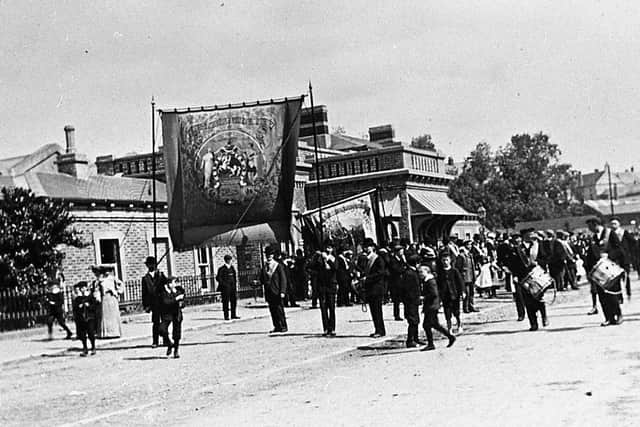

Advertisement
Hide AdAdvertisement
Hide AdBrother Robert Bennett, acting on behalf of the District Master, Brother Henry, who had regrettably been unavoidably absent through illness, proposed a vote of thanks to Mr Temple Reilly for his granting the use of his demesne.
In proposing the resolution Br Bennett referred to the “great kindness always shown” by Mr Temple Reilly to the Orangemen and to the support he had always given to the Orange Institution.
He said: “Mr Reilly was ever willing to do all in his power to assist us. He had done much for Conservatism in the county, and he gave his support to the two popular noblemen who now represent the County Down.”
There then followed loud cheers for Lord Arthur William Hill and Lord Castlereagh, Charles Vane-Tempest Stewart.
Advertisement
Hide AdAdvertisement
Hide AdBro Bennett commented: “Our opponents have not succeeded in obtaining a seat, nor will they ever do so.” Which was greeted by more loud cheering.
He continued: “The Orangemen, I know, are true to their principles, and the two noblemen will forever receive our support.”
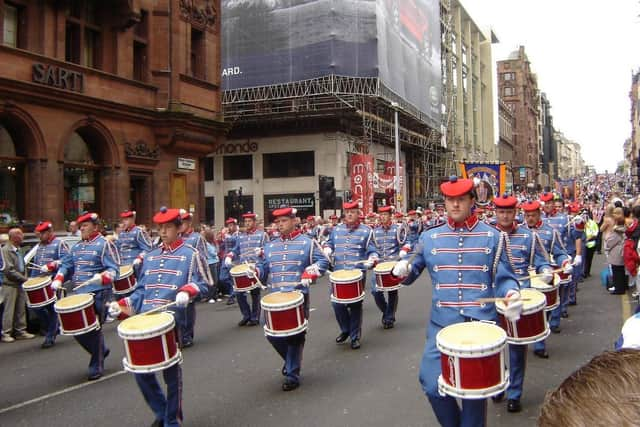

Brother William McDade from Belfast was then called on, as a representative of the visiting brethren to second the vote.
Deafening cheers having been given, the major portion of those present moved in the direction of the field where occasional shots gave indication that “the battle” was about to begin.
Advertisement
Hide AdAdvertisement
Hide AdOccupying a strong position, King James’ army was easily recognised by their green uniforms and they marched to the tune of ‘The White Cockade’, while in the valley King William and his lieutenant, “both on horseback and clad from head to foot in orange”, were seen leading on the loyal forces and marching to the tune of ‘The Protestant Boys’.
In a few moments, “amid the clash of swords and the rattle of musketry”, King William was seen to drive the enemy before them in all directions.
“The fight” over, the procession was reformed, and shortly after four o’clock the very large concourse of people begin to move homeward, “all in good spirits, the strictest orderliness being observed”, each one evidently well content with the manner in which the day had been spent.
BYGONE RELICS EXCITE ‘MUCH CURIOSITY’
Mr Temple Reilly also entertained “a very large company” to lunch during which he had one display “many interesting relics of bygone days that excited much curiosity”, these included the standard of the Lower Iveagh Yeomen Cavalry, on which was woven in letters of gold the motto ‘Our King, Laws, and Constitution’ while on a card attached to the staff were the words: “Presented to the corps by the Marchioness of Downshire, Baroness Sandys; Captain John Lushington Reilly, commandant. This corps was embodied in 1796, and continued until 1816; served with distinction in the battle of Ballynahinch in 1798, pursued the rebels to the Dromara mountains, where they took General Munroe prisoner, concealed in a pig stye, and brought him to Lisburn, where he was hanged.” Attached to the standard was the trumpet used at the battle of Ballynahinch and which was given to Mr John Temple Reilly by the trumpeter.
LURGAN ROYAL BLACK
Advertisement
Hide AdAdvertisement
Hide AdThe News Letter noted that a large number of the members of Royal Black Preceptories in the Lurgan area assembled at the Orange Hall at about ten o’clock and the procession started for Scarva headed by Brother J P Mathers, DM; Brother John Neill, DDM; and Brother James Dickson. The music was supplied by the Gideon Temperance Flute Band, and behind the band the lodges were placed in the following order: Nos 68, 108, 189, 312, 899. Having passed through Market Street, Church Place, High Street and Union Street, the procession, which numbered about 300, then left for Scarva “on brakes and cars”. The entire party returned home again about eight o’clock. The News Letter’s correspondent noted: “The peace was kept by an extra force of police under District-Inspectors Hogbben, Power and Ailworth. Meanwhile at ten o’clock that morning a number of Orangemen left Armagh for the festivities at Scarva in brakes and cars. They were accompanied by the Amateur and Apprentice Boys’ bands and as they were passing through Scotch Street and Barrack Street they were loudly cheered by a large number of sympathisers who had assembled to see them off.
Do you have any old Loyal Order, Royal Black, Apprentice Boys of Derry, marching bands, pipebands etc stories or photographs from yesteryear that you would like to share with News Letter readers? Get in touch, email [email protected].
Comment Guidelines
National World encourages reader discussion on our stories. User feedback, insights and back-and-forth exchanges add a rich layer of context to reporting. Please review our Community Guidelines before commenting.